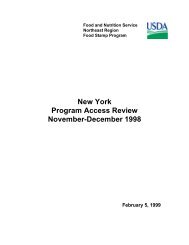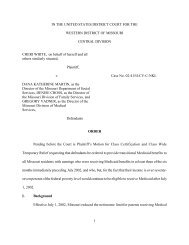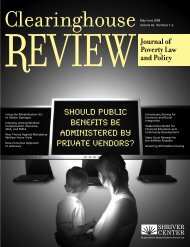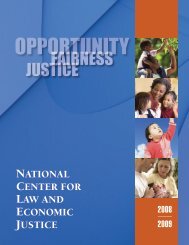The Role of the Courts in Securing Welfare Rights and ...
The Role of the Courts in Securing Welfare Rights and ...
The Role of the Courts in Securing Welfare Rights and ...
Create successful ePaper yourself
Turn your PDF publications into a flip-book with our unique Google optimized e-Paper software.
<strong>Welfare</strong> Law Centeran opportunity to be heard. Lawlessness, arbitrar<strong>in</strong>ess, <strong>and</strong> <strong>in</strong>deed v<strong>in</strong>dictiveness have too <strong>of</strong>tenmarred welfare adm<strong>in</strong>istration <strong>and</strong>, follow<strong>in</strong>g <strong>the</strong> adoption <strong>of</strong> <strong>the</strong> PRA, are likely to <strong>in</strong>crease.Many <strong>of</strong> <strong>the</strong> more arbitrary practices by state <strong>and</strong> local entities are likely to run afoul <strong>of</strong><strong>the</strong> due process clauses <strong>of</strong> <strong>the</strong> federal <strong>and</strong> state constitution. For a court to f<strong>in</strong>d that a dueprocess violation has occurred, <strong>the</strong> court must be satisfied that <strong>the</strong> aggrieved person has aproperty right to <strong>the</strong> benefit at risk.In its l<strong>and</strong>mark decision <strong>in</strong> Goldberg v. Kelly, 84 an early <strong>Welfare</strong> Law Center case, <strong>the</strong>U.S. Supreme Court held that advance notice <strong>and</strong> opportunity for a hear<strong>in</strong>g had to be providedbefore welfare benefits could be term<strong>in</strong>ated. <strong>The</strong> Court found that state law def<strong>in</strong><strong>in</strong>g who waseligible for <strong>the</strong> benefits created a statutory entitlement for eligible claimants, <strong>and</strong> that thisentitlement was a “property <strong>in</strong>terest” protected by <strong>the</strong> Fourteenth Amendment. This decisionled to significant improvements <strong>in</strong> welfare adm<strong>in</strong>istration.Both <strong>the</strong> federal welfare reform statute <strong>and</strong> many state implement<strong>in</strong>g plans provide that<strong>the</strong>re is no longer an entitlement to public assistance. Because <strong>the</strong> issue <strong>of</strong> whe<strong>the</strong>r <strong>the</strong>re is anentitlement is crucial to determ<strong>in</strong><strong>in</strong>g whe<strong>the</strong>r due process rights still exist, courts will first have todeterm<strong>in</strong>e whe<strong>the</strong>r <strong>the</strong>re is a property right to <strong>the</strong> benefits at issue. Arguments that states cannotstrip recipients <strong>of</strong> due process rights by merely stat<strong>in</strong>g that <strong>the</strong>re is “no entitlement” will rely onClevel<strong>and</strong> Bd. <strong>of</strong> Education v. Loudermill, 85 which held that if a statute creates a property<strong>in</strong>terest, <strong>the</strong> due process clause, not <strong>the</strong> statute, determ<strong>in</strong>es what process is due when thatproperty <strong>in</strong>terest is compromised.Once a right to due process has been established, much <strong>of</strong> <strong>the</strong> litigation will focus on what<strong>the</strong> state or locality must do to protect <strong>the</strong> rights <strong>of</strong> <strong>the</strong> welfare recipient or applicant. <strong>The</strong>re hasbeen relatively little litigation filed. However, patterns have emerged that lead us to believe that<strong>the</strong> follow<strong>in</strong>g represent <strong>the</strong> types <strong>of</strong> issues over which litigation will most likely arise.St<strong>and</strong>ardless decision mak<strong>in</strong>g <strong>and</strong> <strong>in</strong>consistent adm<strong>in</strong>istration. <strong>The</strong> greatest erosion<strong>in</strong> fairness has occurred <strong>in</strong> <strong>the</strong> adm<strong>in</strong>istration <strong>of</strong> TANF programs. Far too many states areoperat<strong>in</strong>g <strong>the</strong>ir TANF programs with <strong>in</strong>sufficient st<strong>and</strong>ards <strong>and</strong> <strong>in</strong>adequate oversight <strong>of</strong> <strong>the</strong> workMay 1999⋅ 32 ⋅








